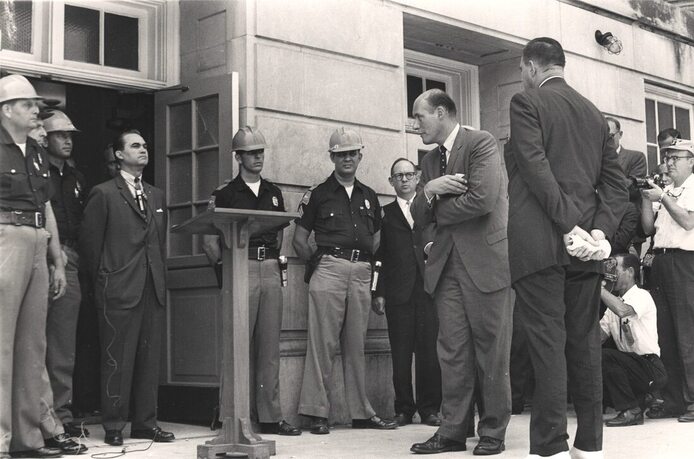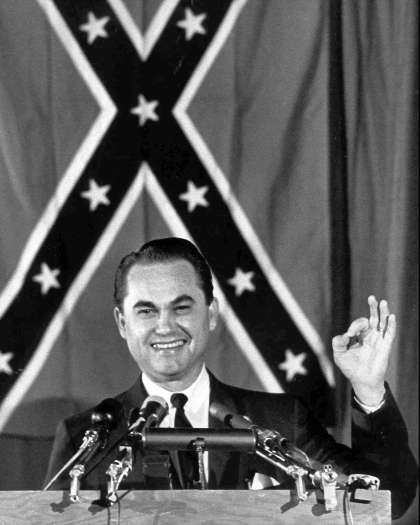
Background
George Corley Wallace was born on August 25, 1919 in Clio, Alabama. Wallace was born to a poor farmer and later attended law school at the University of Alabama. After which he served our country in World War II. He was then elected to serve two terms as an Alabama State legislature. Following his terms he was elected a judge for The Third Court Circuit of Alabama in 1953. His first attempt for Governor of Alabama was unsuccessful losing the Demicratic nomination. Wallace later won the role as Governor in 1962. As talk of integrating the University of Alabama began Wallace pledged to “stand in the schoolhouse door” to block the enrollment of African American students into the University. (George Wallace Paragraph:1-3) Wallace was a known racist and ran his campaign for governor of Alabama and later his campaign for President under the Confederate flag (Frady Paragraph: 1)
Wallace’s Final Stand
On June 11, 1963 two African American Students, James Hood and Vivian Malone, arrived at the University of Alabama to enroll in summer classes. They were met with an unwelcoming site of Governor Wallace standing at five foot seven blocking the schoolhouse door. A crowd formed around Wallace as he gave his saying that he believed he was fighting a (Bell Paragraphs:2-5) “constitutional fight” (Alabama Story). Wallace was first met by a trio of federal officers with a proclamation from President Kennedy urging him to step aside and allow the African American students to enroll. Wallace refused and the officers left. This was followed by hours of near silence as Kennedy federalized the Alabama National. Wallance was then faced with one-hundred uniformed members of the Alabama National Guard (Bell Paragraph: 2). Brigadier General Henry Gram approached Wallace with a salute. He told the Governor “It is my sad duty to ask you to step aside on orders of the President of the United States.” Wallace Agreed to these orders and finally stepped aside after hours of standing and waiting. Wallace promised to continue the fight to keep America’s last all white state university segregated. He did not succeed on this promise (Alabama Story)
George Corley Wallace was born on August 25, 1919 in Clio, Alabama. Wallace was born to a poor farmer and later attended law school at the University of Alabama. After which he served our country in World War II. He was then elected to serve two terms as an Alabama State legislature. Following his terms he was elected a judge for The Third Court Circuit of Alabama in 1953. His first attempt for Governor of Alabama was unsuccessful losing the Demicratic nomination. Wallace later won the role as Governor in 1962. As talk of integrating the University of Alabama began Wallace pledged to “stand in the schoolhouse door” to block the enrollment of African American students into the University. (George Wallace Paragraph:1-3) Wallace was a known racist and ran his campaign for governor of Alabama and later his campaign for President under the Confederate flag (Frady Paragraph: 1)
Wallace’s Final Stand
On June 11, 1963 two African American Students, James Hood and Vivian Malone, arrived at the University of Alabama to enroll in summer classes. They were met with an unwelcoming site of Governor Wallace standing at five foot seven blocking the schoolhouse door. A crowd formed around Wallace as he gave his saying that he believed he was fighting a (Bell Paragraphs:2-5) “constitutional fight” (Alabama Story). Wallace was first met by a trio of federal officers with a proclamation from President Kennedy urging him to step aside and allow the African American students to enroll. Wallace refused and the officers left. This was followed by hours of near silence as Kennedy federalized the Alabama National. Wallance was then faced with one-hundred uniformed members of the Alabama National Guard (Bell Paragraph: 2). Brigadier General Henry Gram approached Wallace with a salute. He told the Governor “It is my sad duty to ask you to step aside on orders of the President of the United States.” Wallace Agreed to these orders and finally stepped aside after hours of standing and waiting. Wallace promised to continue the fight to keep America’s last all white state university segregated. He did not succeed on this promise (Alabama Story)
|
Works Cited "Alabama Story - Negros Enrolled As Governor Yields." Narrated by Ed Herlihy. Universal - International News. Bell, Debra. "George Wallace Stood in a Doorway at the University of Alabama 50 Years Ago Today" ["George Wallace Stood in a Doorway at the University of Alabama 50 Years Ago Today"]. U.S. News, 11 June 2013, www.usnews.com/news/blogs/press-past/2013/06/11/george-wallace-stood-in-a-doorway-at-the-university-of-alabama-50-years-ago-today. Accessed 24 Sept. 2019. Durrett, Melvin King. Interview. 19 Nov. 2015. Frady, Marshall. "How George Wallace Harnessed Hate" ["How George Wallace Harnessed Hate"]. Daily Beast, 3 Apr. 2016, www.thedailybeast.com/how-george-wallace-harnessed-hate?ref=scroll. Accessed 26 Sept. 2019. "George Wallace" ["George Wallace"]. Encyclopædia Britannica, Encyclopædia Britannica, inc., 9 Sept. 2019, www.britannica.com/biography/George-C-Wallace. Accessed 28 Sept. 2019. "Governor George Wallace shot" ["Governor George Wallace shot"]. HISTORY, edited by History.com Editors, A&E Television Networks, 27 July 2019, www.history.com/this-day-in-history/governor-george-wallace-shot. Accessed 26 Sept. 2019. History.com. "George Wallace inaugurated as Alabama governor" ["George Wallace inaugurated as Alabama governor"]. History.com, 27 July 2019, www.history.com/this-day-in-history/george-wallace-inaugurated-as-alabama-governor. Accessed 26 Sept. 2019. History.com Editors. "University of Alabama Desegregation" ["University of Alabama Desegregation"]. History.com, A&E Television Networks, 27 July 2019, www.history.com/this-day-in-history/university-of-alabama-desegregated. Accessed 24 Sept. 2019. How George Wallace Harnessed Hate. Digital file, 3 Apr. 2016. JAMES A. HOOD & VIVIAN MALONE: MADE HISTORY AT THE "STAND IN THE SCHOOLHOUSE DOOR" SHOWDOWN. Black Then, blackthen.com/james-hood-vivian-malone-made-history-stand-schoolhouse-door-showdown/. Accessed 28 Sept. 2019. Op-Ed: George Wallace stoked the fire of racial division that Trump carried all the way to the White House. 1963. Los Angeles Times, www.latimes.com/opinion/op-ed/la-oe-carter-stekler-wallace-racial-language-20180923-story.html. Accessed 27 Sept. 2019. "Students by Race and Ethnicity" ["Students by Race and Ethnicity"]. Office of Institutional Research and Assessment, University of Alabama, oira.ua.edu/factbook/reports/student-enrollment/fall-term/students-by-race-and-ethnicity/. Accessed 29 Sept. 2019. |
Aftermath
The National Guard was active on the Alabama for not very long after that day. A few stayed behind to guard the individual students. A member of the National Guard would walk the African American students to class and stand outside the classroom during the entire class period. The Guardsman would also search people entering rooms that either Vivian Malone or James Hood was in. The African American students also had twenty four hour a day protection because a member of the Alabama National Guard would stand outside of their rooms at night. This was the job of my grandfather, Melvin King Durrett a private at the time in the National Guard, but he later reached the rank of Lieutenant Colonel. Durrett would stand outside of Vivian Malone's dorm room every night. He also had the job of standing in the lobby of the dormitory and searching anyone that entered while Malone was inside of the building. He said, “No one really gave much bother after the first day. People would come and go to classes and were more focused on their own life and education than they were on tourminting some girl they didn’t know. I never saw anything bad, no one ever tried to shoot her (Vivian Malone) or blow her up or anything. In fact I didn’t even carry a real gun. After my first couple of days I was tired of my heavy 1911 pulling my britches down, so I came home and saw Russell (his eight year old child) playing with his toy gun in the yard. I said “Give that here” and placed it in my holster and it was a perfect fit. So from there on out I only carried a fake gun just to look like I had one because no one was going to harm her at all and especially not if they saw a man in uniform with a gun standing there” (Durrett). I am not sure how long Durrett protected Malone and I have no way of asking him, but as he described it, he made it seem that no one cared once African American students were already there. More African American students were enrolled into the University the following year, proving that Wallace had no effect on the integration. Today Alabama has a student population of 38,392 with 4,038 being Black or African Amerian (Students by Race). Wallace continued his political career after serving four terms as governor of Alabama he attempted to run for president. Wallace ran three times losing every time. While Wallace was hosting a rally in Maryland on May 15, 1972 he was shot. A man by the name of Arthur Bremer pulled a gun and shot Wallace and injuried three others. Wallace was left fighting for his life in the hospital but the next day he won both the state of Michigan and Maryland. This didn’t matter considering he was left paralized from the waist down effectively ending his political career (Governor George Paragraph: 1). |


